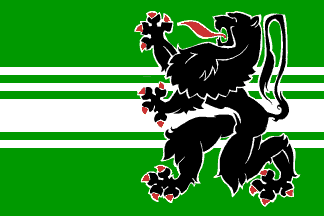 by Mark Sensen
by Mark Sensen
Last modified: 2003-03-21 by ivan sache
Keywords: flanders | lion (black) | east flanders | oost-vlaanderen | flandre orientale | proposal | coat of arms | river | governor |
Links: FOTW homepage |
search |
disclaimer and copyright |
write us |
mirrors
See also:
Michel Lupant gave me a photocopy of the Belgian Gazetteer
(Moniteur Belge/Belgisch Staatsblad) of14 April 1999 Ed.2, in
which the decree of 14 December 1998 was published by which the
Flemish minister of Culture, Family and Welfare imposed (!) flag and
coat-of-arms on the province of East Flanders.
The official description of the flag is (translated from
Dutch/Flemish):
'Three stripes with proportions 5:6:5, the upper and lower stripe
green, the middle stripe alternate white and green with proportions
1:1:1:1:4:1:1, in the fly a black lion with red nails and
tongue.'
The appendix has images of the coat-of-arms and flag.
In the original drawing the lion had three nails at each claw, which was rejected. The original artist refused to change this to four nails, so another artist had to be found to make a new drawing. In this new drawing the lion is less modern than in the original one. Michel Lupant told us that the rejected flag was used unofficially, and that someone had seen a square version.
Mark Sensen, 29 May 1999
Green and white should be the authentic medieval colours of East
Flanders and also represent the increasing concern for environment.
The four white lines represent the rivers which cross the province,
the thickest line representing the Scheldt (Schelde/Escaut).
The colour specifications are:
Jan Cuelenaere, 19 June 1999
This proposal adopted by the Provincial Council was rejected by
the Heraldic Council on 21 March 1996 because the lion had only
three nails to each paw. Normally an heraldic lion has four
nails, but this isn't always the case. See for instance the Greater
coat of arms of Bavaria where the Palatinate
lion has also three nails, the Souabe leopards also, as well as some
paws of the supporters.
So: were these three nails the problem for the adoption of this flag
(and coat of arms since the lion in the shield of the coat of arms of
the province is the same) the true reason for the non official
recognition of the emblems by the Flemish authorities? Can we think
also that the problem appeared because the drawing of this lion is
very stylised contrary to the other heraldical lions in the other
provinces?
Anyway, though the flag hasn't been officially recognized, it has
been already produced by Flemish flag manufacturers, but ...with a
four nail lion, as one can see in the city of
Bruges
(West-Flanders). According to the law
concerning the flags of Flemish provinces, if the flag of a province
cannot be approved by the Flemish Heraldical Council, this last
adopts one for the province.
The flag and the coat of arms of East Flanders were drawn by the
heraldist and painter Fernand Broose, who has already drawn the flag
and the coat of arms of the Belgian German
speaking Community.
Pascal Vagnat, 4 January 1999
![[East Flanders banner of arms]](../images/b/be)vov.gif) from the
Shipmate site, with permission
from the
Shipmate site, with permission
Lion rampant sable, tongued and nailed gules, on or.
Filip van Laenen
The colours were taken from the arms. These colours were not fixed. Various sources give different designs, but two main sets can be compiled.
I have some xerox copies of sheets which seam to come from a book
(bilingual Dutch and French) containing regulations (for the Navy
maybe?). It contains a sheet with the honorary flags of the governors
of the provinces, adopted by Order in Council of 28 October 1936.
It includes a construction sheet. The flags are 150x150 cm. Each
stripe is 50 cm. The shields are 43.5 cm. wide and 50 cm. high
excluding 3.75 cm for the point of the shield. The shields are in the
center of the black stripe.
Mark Sensen, 27 January 2001